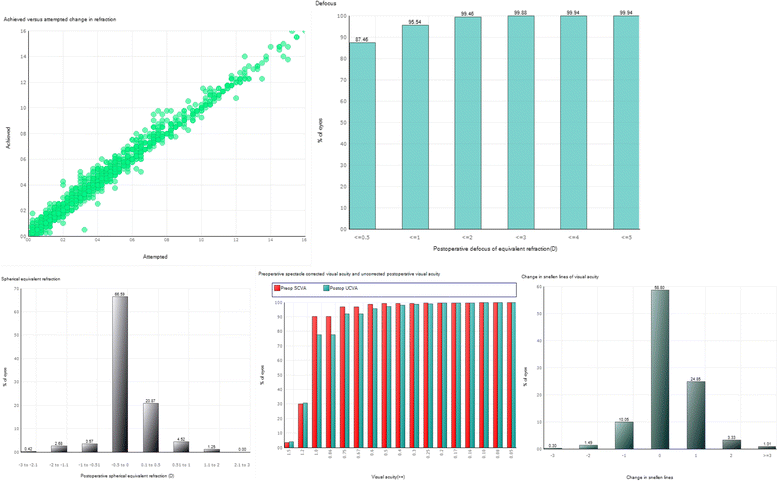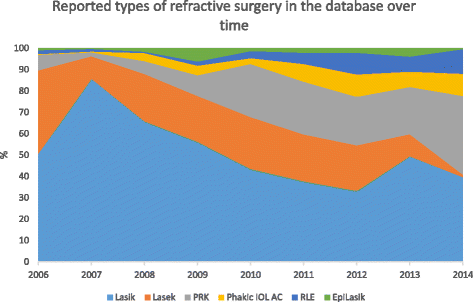The European registry of quality outcomes for cataract and refractive surgery (EUREQUO): a database study of trends in volumes, surgical techniques and outcomes of refractive surgery
- PMID: 26613089
- PMCID: PMC4660846
- DOI: 10.1186/s40662-015-0019-1
The European registry of quality outcomes for cataract and refractive surgery (EUREQUO): a database study of trends in volumes, surgical techniques and outcomes of refractive surgery
Abstract
Background: A European web-based registry for refractive surgery was established in 2008; The European Registry of Quality Outcomes for Cataract and Refractive Surgery (EUREQUO). The aim of the registry was to improve treatment and standards of care for refractive surgery. Further aims were to offer a tool for benchmarking by establishing a reference database and for surgeons to enter and analyze their own outcomes. The purpose of this study was to characterize the registry and analyze the data collected during its first decade.
Methods: The characteristics of the web-based registry are described. Data collected from February 4(th) 2004 until June 30(th) 2014 are included in the analysis. The database is analyzed in terms of surgical technique, indications for surgery, complications, and refractive and visual outcomes.
Results: Data have been reported from 47 centers in 14 countries until mid-2014. About 4,000 procedures were reported annually. The most frequent procedure was laser-assisted in-situ keratomileusis (LASIK) with 11697 reported surgeries. Over time in the database, LASIK declined (p < 0.001) while photorefractive keratectomy (PRK) and refractive lens exchange (RLE) increased (p < 0.001 for both procedures). The indications for surgery, in terms of preoperative refraction and age, were stable over time, for all types of procedures. Surgical complications were reported infrequently and with a well-known relationship to the type of surgical procedure. The reported refractive outcomes were good. The visual outcomes indicate a significant increase of visual acuity after high myopia treatment by phakic intraocular lens in the anterior (phakic IOL AC) and the posterior (phakic IOL PC) chamber and a poorer visual outcome, after both myopia and hyperopia treatment, by epithelial LASIK (Epi-LASIK).
Conclusions: We describe the establishment of a European registry for refractive surgery. The database increases at a rate of approximately 4000 refractive procedures per year. The most frequent procedure is LASIK, but both PRK and RLE are an increasing part of the reported procedures. The indications for surgery have been stable over time. Surgical complications and visual outcome vary, depending on the type of surgery.
Keywords: European database; Outcomes; Refractive surgery; Registry.
Figures



Similar articles
-
A Multicenter Retrospective Survey of Refractive Surgery in 78,248 Eyes.J Refract Surg. 2017 Sep 1;33(9):598-602. doi: 10.3928/1081597X-20170621-01. J Refract Surg. 2017. PMID: 28880334
-
Comparison of photorefractive keratectomy, astigmatic PRK, laser in situ keratomileusis, and astigmatic LASIK in the treatment of myopia.J Cataract Refract Surg. 2002 Mar;28(3):462-76. doi: 10.1016/s0886-3350(01)01177-4. J Cataract Refract Surg. 2002. PMID: 11973093
-
Femtosecond laser-assisted cataract surgeries reported to the European Registry of Quality Outcomes for Cataract and Refractive Surgery: Baseline characteristics, surgical procedure, and outcomes.J Cataract Refract Surg. 2017 Dec;43(12):1549-1556. doi: 10.1016/j.jcrs.2017.09.029. J Cataract Refract Surg. 2017. PMID: 29335099
-
Refractive surgery in children: treatment options, outcomes, and controversies.Am J Ophthalmol. 2009 Apr;147(4):573-582.e2. doi: 10.1016/j.ajo.2008.12.028. Am J Ophthalmol. 2009. PMID: 19327445 Review.
-
Surgical options for correction of refractive error following cataract surgery.Eye Vis (Lond). 2014 Oct 16;1:2. doi: 10.1186/s40662-014-0002-2. eCollection 2014. Eye Vis (Lond). 2014. PMID: 26605349 Free PMC article. Review.
Cited by
-
Clear lens extraction for patients who are unfit for laser-assisted in situ keratomileusis and implantable contact lenses in central Indian population.Indian J Ophthalmol. 2020 Dec;68(12):3002-3005. doi: 10.4103/ijo.IJO_1307_20. Indian J Ophthalmol. 2020. PMID: 33229686 Free PMC article.
-
Early Results with a New Posterior Chamber Phakic Intraocular Lens in Patients with High Myopia.J Ophthalmol. 2018 Jun 19;2018:1329874. doi: 10.1155/2018/1329874. eCollection 2018. J Ophthalmol. 2018. PMID: 30018818 Free PMC article.
-
Ectasia After Corneal Refractive Surgery: A Systematic Review.Ophthalmol Ther. 2021 Dec;10(4):753-776. doi: 10.1007/s40123-021-00383-w. Epub 2021 Aug 20. Ophthalmol Ther. 2021. PMID: 34417707 Free PMC article. Review.
-
Epidemiological insights into complication and outcomes in corneal refractive surgery population: findings from KNHANES 2010-2012.BMC Ophthalmol. 2025 Mar 28;25(1):154. doi: 10.1186/s12886-025-03981-5. BMC Ophthalmol. 2025. PMID: 40155855 Free PMC article.
-
Lens Factor Choice in IOL Power Calculation after Laser Refractive Surgery: The Right Constant for Advanced Lens Measurement Approach (ALMA).J Clin Med. 2024 Sep 1;13(17):5186. doi: 10.3390/jcm13175186. J Clin Med. 2024. PMID: 39274399 Free PMC article.
References
-
- Lockington D, Johnson R, Patel DV, McGhee CN. Healthcare and a holiday: the risks of LASIK tourism. Clin Exp Optom. 2014;97:370–2. - PubMed
LinkOut - more resources
Full Text Sources
Other Literature Sources

